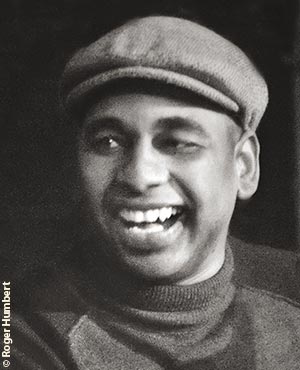 |
Roberto Linares Brown
an interview conducted by Tracy Jenkins (photos by Roger Humbert) |
|
|
|
|
|
|
|
|
| Roberto Linares Brown, known in Cuba as "el Seña", was born April 2nd, 1976 in the city of Guaimaro Camaguey. At the age of 9 he began his studies as a musician, specializing in percussion, both classical and Cuban, in the vocational music school of his native province. |
|
During the course of his studies, he began to compose original music, always inclining towards popular Cuban music. He finished his studies in June of 1996 and began his professional career working with various orchestras: Valentin y los 10 del Caribe, which worked mostly in International Tourism, where Brown learned an international repertory and also stage production. He moved to the capital La Habana, and joined the Orquesta Azucar Negra as a pianist.
In June 2001, Brown joined one of the foremost orchestras of Cuba, Adalberto Alvares y su son, where he worked for four years as a composer and arranger. He was the arranger of their last three CDs, as well as composer of a number of the selections.
With Adalberto Alvares y su son, Brown traveled internationally to over twenty countries, including the United States, Canada, Italy, France, Switzerland, Denmark, Austria, Japan, Mexico, Venezuela, Peru and others. He has recently moved to Canada, where he wants to concentrate on creating his own compositions.
|
|

Roberto Linares Brown |
|
| Roberto Linares Brown is the Musical Director resident at The Headroom Productions and also arranger and composer for the different musicians that work at the Studio. |
|
| Tracy Jenkins How did you get the nick name “El Seña”.
Roberto Linares Brown Una seña means a wink. The way you wink when you are teasing or making a joke. In school, I had a reputation for making a lot of jokes.
TJ Can you tell us a bit about the title of your album, Que no se pierda la esencia (That the Essence not be lost).
RLB In the album, I explore many genres of music and many rhythms. To me it’s very important to preserve all of the Cuban rhythms. In the album there’s a lot of fusion between salsa and other styles such as reggaeton and hip hop. But while I explore these other sounds, I don’t want to loose the roots of the the music. The common thread between all the songs on the album is that they all maintain their roots. For all the songs the essence is Cuban son. Cuban son is the inspiration for all these songs. Cuban son is present throughout the album and is revealed behind each style.
TJ What’s different about working here in Toronto than back in Cuba?
RLB When I was in Cuba, we musicians were always looking outside of the country for inspiration. On the island, our influences were external. Now that I’m here in Toronto and surrounded by so many different types of music all the time, I find myself looking inward for inspiration. Working here in Toronto, I am finding my creative centre within myself. I guess, being in Toronto has helped me find my “voice” as a composer and musician.
I’ve never lived in another country so this is my first experience like this. Coming to Canada, made me realize how important the path of Cuban music has been outside of Cuba. I see Cuban music within a bigger context and I see how strong and how big it is.
TJ Would you say that there is a Toronto Cuban sound?
|
|
RLB Yes, there is a sound here that’s different than back in Cuba. Partly for the reasons that I just talked about. I think most of the Cuban musicians that have come to Canada recently have experienced something similar. We are looking back to Cuba and drawing on the strength of that tradition. At the same time, we’re living in such a multicultural city. We are exposed to very diverse influences all the time. We all see our roots differently when we’re away from home. Then we Cuban musicians get together here in Toronto and produce a very unique sound — it’s something Cuban but within the Canadian context.
TJ The album features several well known Cuban Canadian singers such as Yani Borrell, Jesus El Niño and Alberto Alberto. How did you choose the singer for each song?
RLB After I wrote each song, I knew which singers I wanted for each. I chose the singer that would be best suited to the style of the piece based on their timber and form of expression. For example, I knew that El Niño was going to sound great on “Dale Tumbao”. I wanted to draw on the wealth of Cuban talent that we have here in Canada. The album also includes one piece featuring my uncle Julian Yackson Linares on vocals. My uncle recorded the vocal track back in Cuba and we mixed it together here in Toronto.
|
|
 |
|
| TJ What are you planning next?
RLB I am looking at several projects. I want to continue to work with Cuban musicians based in Europe and the United states. If this album is well-received, I’d like to make a solo album with a local vocalist such as Yani Borrell or one of the other singers on Que no se pierda la esencia. Another interesting project would be to work on a fusion album that incorporates more hip hop, reggae and rap. I also hope to work on a Christian album later this year. Both of these projects would be with a variety of singers.
|
|
|
|
|
|



